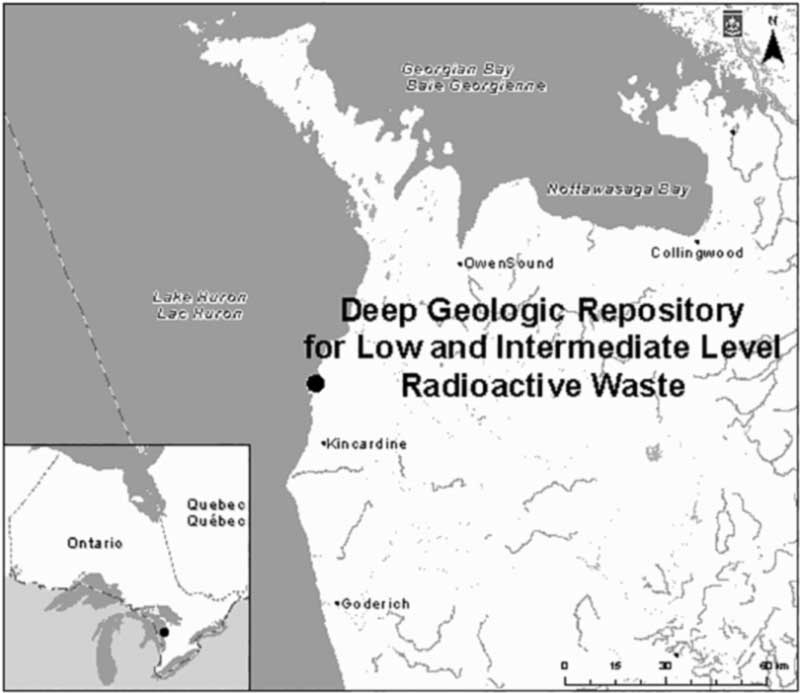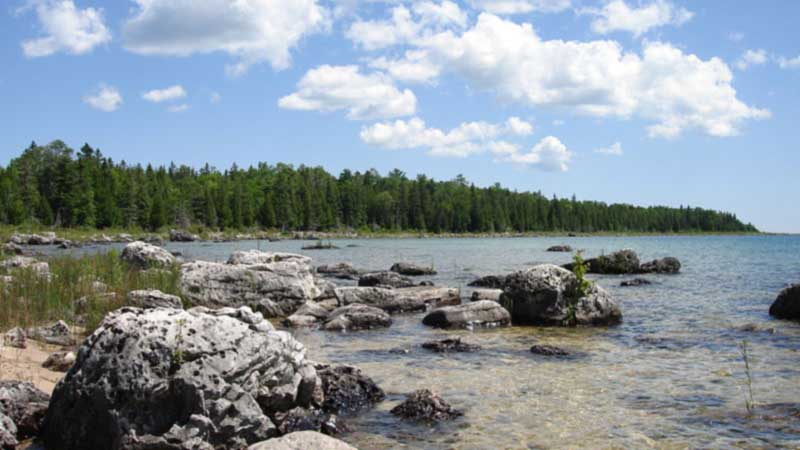TORONTO—The public commentary period on plans to build a permanent storage site for low to medium radioactive waste from nuclear plants such as clothing, tools and parts deep within the limestone formation less than a mile from the shores of Lake Huron ends on Monday, March 6, and the proponents are citing a lack of participation as a sign that the plan is not very high on Ontarians’ radar.
Ontario Power Generation’s (OPG) proposed Deep Geological Repository (DGR) would store low and intermediate level nuclear waste deep beneath the earth’s surface beside OPG’s Western Waste Management Facility at the Bruce nuclear generating station located in Kincardine.
Designed to hold about 200,000 cubic metres of low and intermediate level waste from Ontario’s nuclear generating stations, loads of radioactive mops, rags, paper towels and clothing (aka low level waste) would be joined by the more radioactive waste such as filters, resins and pressure tubes, most of which is currently stored above ground in specialized storage buildings. No spent fuel rods would be part of this group.
The ion shielding resins included in the intermediate waste category contain significant amounts of carbon-14, a radionuclide that has a half life of more than 5,700 years. A long term solution is therefore obviously a high priority.
The DGR would be carved out of the sedimentary shale and limestone rock, some 680 metres (2,230 feet) below the surface in rock formations that OPG’s research has determined have been stable for more than 450 million years. But the site is located less than a mile from the shores of Lake Huron and the opposition to the facility has been widespread despite the $130 million in research spent by the OPG since 2001 and a 450-page report by the Canadian Environmental Assessment Agency endorsed by the joint review panel appointed to oversee the proposal. The proponents like to point out that the storage facility is “450 million years away from Lake Huron.” Opponents take little comfort in either the endorsements or the analogy.
“This idea of a ‘dump’ for nuclear waste has been the only option explored by CNSC since the ‘60s,” notes Sandfield’s Sarah Hutchinson, CEO for the Algoma-Manitoulin Green Party of Ontario Constituency Association and a vocal opponent of the plan. “In Europe, they are only pursuing plans for nuclear waste management facilities. The difference is, in a dump such as that proposed for Kincardine, if something goes wrong the material is irretrievable. In a management facility, the canisters for the waste can be serviced or changed if needed. Of course a management facility is much, much more expensive. What’s important to know is that this facility will be the first of its kind in the world. Scientists agree that the synergy of heat from the earth, moisture and pressure will have an effect on the canisters in ways we do not yet fully understand. To me it seems dangerous to create an experiment we can not control with radioactive waste, and goes against the Green precautionary principle.”
Ms. Hutchinson is far from alone in her concerns, in fact, more than 160 cities, counties and states around the Great Lakes have weighed in with resolutions opposing the repository, including heavyweights like the American cities of Detroit, Milwaukee and Chicago, as well as Ontario’s Toronto. The Saugeen First Nation, upon whose traditional territories the DGR would be located have also weighed in against the proposal.
Despite the upwelling of opposition, both the US Environmental Protection Agency and the Michigan Department of Environmental Quality have clearly stated they have no objection to the project. The Town of Kincardine, the proposed location for the DGR, is, however, onside with the plan.
Opponents of the DGR have criticized the proponents for not exploring alternative sites that are not located beside the Great Lakes from which literally tens of millions of people draw their drinking water. In response to a government request to the OPG to provide a map of alternative sites for the DGR, OPG interpreted those instructions to mean other possible geological formations, one consisting of crystalline rock (aka granite) and one of sedimentary rock. Those two formations cover an area that encompasses roughly three-quarters of the province.
OPG maintains that they have met the minister’s parameters by distinguishing between a “site” and a “location.” Identifying an alternative “site,” they contend, would involve a multi-year process, complete with multiple phases, that would include finding another willing host—basically starting the process all over again from scratch, while simply identifying an alternative location involves identifying which geological formations are technically and economically feasible.
The semantic gymnastics can likely be traced to the bottom line. Finding an alternate location at this point would entail something on the order of $380 million to $1.4 billion dollars. Nothing nuclear comes cheap, it seems.
The comment period on the latest information submitted by the OPG on the DGR ends on March 6. So far, the OPG contends that the facility is not generating much interest on the public’s radar. On Monday, December 12, 2016 the Governor in Council extended the time limit for the issuance of a decision statement by 243 days.
The documents to weigh in on the project’s pros and cons can be found at www.ceaa-acee.gc.ca.





